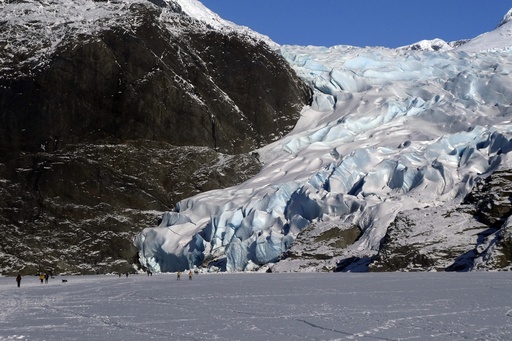
Recent research indicates that climate change is rapidly accelerating the melting of mountain glaciers worldwide. A comprehensive study revealed that these glaciers are now shrinking at more than double the pace observed in the early 2000s.
Between 2000 and 2011, the glaciers lost roughly 255 billion tons (231 billion metric tons) of ice annually. However, this loss surged to about 346 billion tons (314 billion metric tons) per year over the subsequent decade. The last few years have seen an even sharper increase, culminating in a staggering loss of 604 billion tons (548 billion metric tons) in 2023, marking the highest loss recorded in this analysis.
This study incorporates an international collaboration that presents a total of 233 separate assessments on glacier mass changes. Since the start of the new millennium, glaciers around the globe have shed over 7 trillion tons of ice (6.5 trillion metric tons). William Colgan, a glaciologist from the Geological Survey of Denmark and Greenland, emphasized that the facts reveal a concerning trend: “The glaciers are indeed retreating and disappearing, as we predicted. The rate of loss appears to be escalating.”
The findings show that glaciers in Alaska are experiencing the most rapid melt among the 19 regions analyzed, with an annual ice loss of approximately 67 billion tons (61 billion metric tons). Central Europe’s glaciers have reported the most significant percentage of ice loss over the last 24 years, shrinking by 39% since 2000. Colgan expressed particular concern for the Alps, which are facing severe impacts due to heightened summer temperatures.
Although scientists previously expressed major concerns about the glaciers in the Andes and Patagonia, the alarming rate at which the Alps are declining could lead to their possible disappearance in the future. “Glaciers are unbiased indicators of climate change, and their decline starkly illustrates the increase in global temperatures,” noted Gwenn Flowers, a professor of Earth Sciences at Simon Fraser University in Canada.
According to Ted Scambos, an ice scientist from the University of Colorado, the current trends differ markedly from past glacier cycles, which were influenced by local conditions rather than global climate change. He asserted that greenhouse gas emissions from burning fossil fuels are directly responsible for the current glacier shrinkage. “No amount of discussion or proclamations will alter the reality of this situation,” he stated.
Colgan remarked that while regions like the western United States may currently benefit from increased water flow due to rapid glacier melting, this advantage will soon dissipate once glaciers retreat beyond a critical threshold. The research also suggested that melting glaciers are contributing more to sea level rise than ice loss from Greenland or Antarctica, with thermal expansion of warm water being the only more significant factor in the rising sea levels.
The findings indicate that although the glacier loss rate aligns closely with previous, albeit less comprehensive, studies, updates may lead to gloomier forecasts due to improved data and escalating temperatures. “Losing 5.5% of global ice volume in just over two decades is clearly unsustainable,” Colgan added. “This will eventually lead to significant consequences.”
He concluded that the over 600 billion tons of glacier loss recorded in 2023 may seem astonishing now, yet it could become commonplace within a decade, hinting at a rapidly shifting trend where mountain glaciers could transition into a phase of swift collective ice loss.

